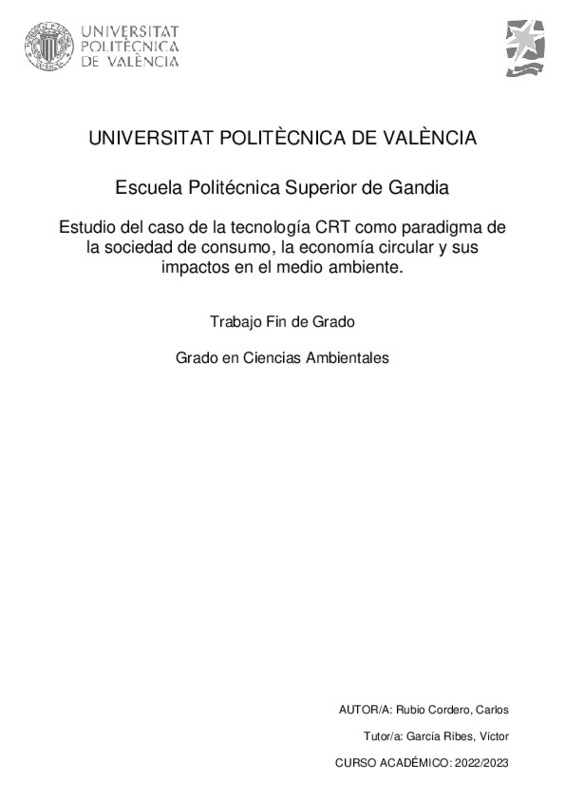|
Resumen:
|
[ES] Este Trabajo de fin de grado (TFG) tiene como objetivo investigar el caso de los televisores y monitores de tubo de rayos catódicos o CRT en sus siglas en inglés como un ejemplo de tecnología que fue remplazada por ...[+]
[ES] Este Trabajo de fin de grado (TFG) tiene como objetivo investigar el caso de los televisores y monitores de tubo de rayos catódicos o CRT en sus siglas en inglés como un ejemplo de tecnología que fue remplazada por otra nueva y dejó la anterior obsoleta a ojos del consumidor y la industria. La motivación de este TFG se basa en mi propia experiencia durante años en los cuales he encontrado decenas de televisores CRT al lado de los contenedores de basura doméstica, los he ido recolectando y además probando. De alrededor de 50 CRTs recogidos solo 1 no funcionaba a la hora de probarlo, lo cual hace reflexionar acerca del motivo por el cual los usuarios se han desecho de ellos. De esta manera surgen diversas hipótesis que se discutirán a lo largo del TFG apoyadas en información obtenida a través de diversas entrevistas. Algunas de ellas a implicados en la gestión de los RAEE de la propia UPV (Universitat Politècnica de València) ya que es una institución pública que ha hecho uso de gran cantidad de monitores CRT y ha tenido que contratar a gestores que los gestionen de forma correcta una vez han dejado de utilizarse. A raíz de términos como "gestión de los RAEE" se investigará la normativa vigente al respecto de qué es considerado un "residuo" y se analizará desde un punto de vista relacionado con la educación ambiental discutiendo si la definición de aquello que se considera residuo debería ser replanteado. Conceptos como el de economía circular, innovación incremental y el de producción y consumo responsable que presenta el Objetivo de desarrollo sostenible 12 (ODS 12) se relacionan con el tema de este TFG en el que además se investigará las vías en las cuales la tecnología antigua como es el caso de los CRT puede seguir formando parte de la sociedad. También se investigará el papel de las aplicaciones de venta de segunda mano entre particulares, tiendas de segunda mano y mercadillos o rastro además de la revalorización que sufren actualmente los objetos antiguos.
[-]
[EN] This dissertation aims to investigate the case of cathode ray tube (CRT) televisions and monitors as an example of a technology that was replaced by a new technology and made the old one obsolete in the eyes of the ...[+]
[EN] This dissertation aims to investigate the case of cathode ray tube (CRT) televisions and monitors as an example of a technology that was replaced by a new technology and made the old one obsolete in the eyes of the consumer and the industry.
The motivation for this TFG is based on my own experience over the years in which I have found dozens of CRT televisions next to household waste bins, collected them and tested them. Out of about 50 CRTs collected, only 1 did not work when tested, which makes me wonder why users have thrown them away. In this way, several hypotheses emerge that will be discussed throughout the dissertation, supported by information obtained through various interviews. Some of them involve those involved in the management of WEEE at the UPV (Universitat Politècnica de València) itself, as it is a public institution that has made use of a large number of CRT monitors and has had to contract managers to manage them correctly once they are no longer in use.
Following terms such as "WEEE management", the current regulations on what is considered "waste" will be investigated and analysed from an environmental education point of view, discussing whether the definition of what is considered waste should be reconsidered.
Concepts such as the circular economy, incremental innovation and responsible production and consumption as presented in Sustainable Development Goal 12 (SDG 12) are related to the topic of this dissertation, which will also investigate the ways in which old technology such as CRTs can continue to be part of society. The role of second-hand sales applications between individuals, second-hand shops and flea markets will be investigated, as well as the current revaluation of antique objects.
[-]
|





![ZIP archive [ZIP]](/themes/UPV/images/zip.png)


